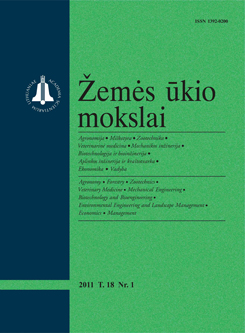Žemės ūkio mokslai / Agricultural Sciences
WHAT?
 ISSN 1392-0200 |
2004 m. Nr. 3 Šlaitų dirvožemio vandeninės erozijos priklausomybė nuo žemdirbystės sistemų
Research data were obtained on
sandy loam Eutric Albeluvisols at the Kaltinėnai Research Station of the
Lithuanian Institute of Agriculture on the undulating hilly topography of the Žemaičiai
Upland of Western Lithuania. A combination of perennial grass species and
selected crop rotations can help prevent soil erosion in upland regions and
minimize the risk of soil erosion and associated water pollution. The aim was
to identity crop and crop rotations as different land use systems that would minimize
soil erosion during a long-term period. The measured water erosion rates
according to 18 years of field experiments were: 3.17– 8.6 m3 ha–1
yr–1 under winter rye, 9.01–27.09 m3 ha–1 yr–1 under springo barley and
24.2–87.12 m3 ha–1 yr–1 under potatoes. Perennial grasses completely
prevented water erosion. The erosion-preventive grass–grain crop rotations
(66.7% of grass) decreased soil losses on arable slopes of 2–5°, 5–10° and
10–14° by 74.7–79.5%, while the grain–grass crop rotation (33.3% of grass)
decreased the rates by 22.7–24.2% compared with the field crop rotation. The
main attributes of the proposed land conservation and sustainable land-use
system were careful selection of optimum erosion-preventive ecosystems
(sod-forming perennial grasses or erosion-preventive crop rotations) with high
erosion-resisting capabilities. These systems would vary in response to slope
and soil conditions.Such ecosystems assist erosion
control and thus the ecological stability of the undulating topography. These
results may have a wider applicability on the undulating landscapes of the
temperate climate zone.
Raktažodžiai: undulating hilly topography, water erosion rates, erosionpreventive crop rotations, temperate climate |
Numeriai:
2012 - T.19 Nr.1 2011 - T.18 Nr.1, Nr.2, Nr.3, Nr.4 2010 - T.17 Nr.1-2, Nr.3-4 2009 - T.16 Nr.1-2, Nr.3-4 2008 - T.15 Nr.1, Nr.2, Nr.3, Nr.4 2007 - T.14 Nr.1, Nr.2, Nr.3, Nr.4, Nr.Priedas 2006 Nr.1, Nr.1.Priedas, Nr.2, Nr.3, Nr.4 2005 Nr.1, Nr.2, Nr.3, Nr.4 2004 Nr.1, Nr.2, Nr.3, Nr.4 2003 Nr.1, Nr.2, Nr.3, Nr.4 2002 Nr.1, Nr.2, Nr.3, Nr.4 2001 Nr.1, Nr.2, Nr.3, Nr.4 |